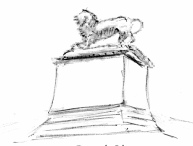



The Parish Church of St George the Martyr, Waterlooville

New Year bells in Bruxelles
Following their now established custom of celebrating the New Year in a different capital of Europe, Barbara and Rod selected Brussels (also spelled Brussel or Bruxelles according to ethnic and political allegiance) to get away for the festive season. This city, regarded as the unofficial capital of Europe, is a vibrant and exciting place to be, whatever the season, and is very well served at festival times. Eurostar from St Pancras was the method of travel. St Pancras itself is a marvel of majestic Victorian construction. The glass vaulting of the vast roof is reminiscent of that of the Quai d’Orsay in Paris, and the exterior brick edifice is of sublime and awesome proportions. The statue of John Betjeman the poet laureate stands in bronze at the upper level and a beautiful sculpture -
The hotel accommodation, just off Grand Place, in the rue du marché des herbes, was ideally situated for walking to places of exciting action, despite the roughly cobbled streets of the old town and the bitterly cold weather. Transport is also very efficient -
New Year was ushered in at the remarkable Grand Place, reckoned to be the finest square in Europe. Its architecture, principally of City Hall and the various Guild Houses, flanked on one side by the mansion of the Dukes of Brabant, was the scene of a magnificent light show. A substantial nativity scene had been erected in the square which was packed with people. As the New Year approached, the bells of the churches rang out and a superb firework display from nearby Central filled the air, and bystanders wished each other ‘Bonne Année’.
Amongst the activities which Barbara and Rod engaged in, were:
• A visit to the scene of the battle of Waterloo
• Ice skating in the district of St Catherine
• Entertainment in a Mongolian set of displays
• Mass at the Cathedral dedicated to Saints Michael and Gudule
• Time spent in the musée des Beaux Arts.
The Waterloo Battlefield
Barbara and Rod took the tram and train to Waterloo, a cheerless and drab town some miles south of Brussels. A long walk took them to Wellington’s Headquarters with gates emblazoned with the cipher 1 8 1 5. Four kilometres further down was the actual battleground, marked by an enormous pyramidal mound -
Ice Skating
Near the Church of St Catherine was yet another Christmas Market, where gluwein, courtesy of Lions International, was drunk. Further along was an open air ice rink where Rod exercised his enthusiasm in skating for nearly an hour.
Mongolian Section
In the same area was a collection of Mongolian yurts (round huts) where enthralling displays were held. In one part there was a four-
The Cathedral
The couple went to mass at the Cathedral Church of Saints Michael and Gudule. The latter is not widely known but is said to be a woman of purity who lived 1300 years ago. Both are patron saints of Brussels. The edifice dominates a wooded square and the frontage has recently been cleaned. The service was beautiful, the organ playing and devotional music being particularly fine. Rod remembered from his past that the setting was most similar to one of his choirboy youth -
The Musée des Beaux Arts
Works by Van Dyck, Rubens and Breughal, amongst others were seen at the museum. The visitors were particularly interested in a scene described in Luke II:
“And it came to pass in those days that there went out a decree from Caesar Augustus that all the world should be taxed... And all went to be taxed, everyone to his own city...”
Two paintings of Mary and Joseph going to Bethlehem for this purpose were in the same room. Both were by a Breughal. It was exciting to examine and compare the two -
Brussels is famous for its chocolate and beer. Both were partaken in abundance. A truly wonderful experience not only for these but all the things seen and done in this wonderful city.
Rod Dawson
Easter and Spring Edition 2010
